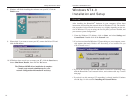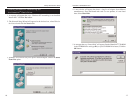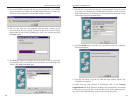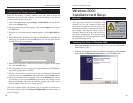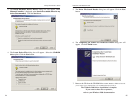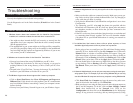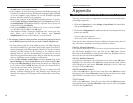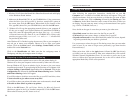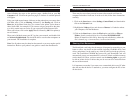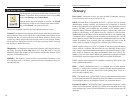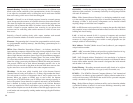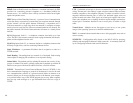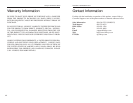
IPCONFIG - A utility that provides for querying, defining and managing IP
addresses within a network. A commonly used utility for configuring networks
with static IP addresses.
IPSec - IPSec (Internet Protocol Security) is a developing standard for securi-
ty at the network or packet processing layer of network communication. A big
advantage of IPSec is that security arrangements can be handled without
requiring changes to individual user computers.
ISP - An ISP (Internet service provider) is a company that provides individuals
and companies access to the Internet and other related services such as Web site
building and virtual hosting.
LAN - A local area network (LAN) is a group of computers and associated
devices that share a common communications line and typically share the
resources of a single processor or server within a small geographic area (for
example, within an office building).
MAC Address - The MAC (Media Access Control) address is your computer's
unique hardware number.
mIRC - mIRC runs under Windows and provides a graphical interface for log-
ging onto IRC servers and listing, joining and leaving channels.
NAT - NAT (Network Address Translation) is the translation of an Internet
Protocol address (IP address) used within one network to a different IP address
known within another network. One network is designated the inside network
and the other is the outside.
Packet Filtering - Discarding unwanted network traffic based on its originat-
ing address or range of addresses or its type (e-mail, file transfer, etc.).
PCMCIA - The PCMCIA (Personal Computer Memory Card International
Association) is an industry group organized in 1989 to promote standards for a
credit card-size memory or I/O device that would fit into a personal computer,
usually a notebook or laptop computer.
Ping - (Packet INternet Groper) An Internet utility used to determine whether
a particular IP address is online. It is used to test and debug a network by send-
ing out a packet and waiting for a response.
3736
Phoneline 10M Network Card
Linksys HomeLink
®
Series
Dynamic Routing - The ability for a router to forward data via a different route
based on the current conditions of the communications circuits. For example,
it can adjust for overloaded traffic or failing lines and is much more flexible
than static routing, which uses a fixed forwarding path.
Firewall - A firewall is a set of related programs, located at a network gateway
server, that protects the resources of a network from users from other networks.
(The term also implies the security policy that is used with the programs.) An
enterprise with an intranet that allows its workers access to the wider Internet
installs a firewall to prevent outsiders from accessing its own private data
resources and for controlling what outside resources to which its own users
have access.
Basically, a firewall, working closely with a router, examines each network
packet to determine whether to forward it toward its destination.
Firmware - Programming that is inserted into programmable read-only mem-
ory (programmable read-only memory), thus becoming a permanent part of a
computing device.
HPNA (Home Phoneline Networking Alliance) - An industry standard for
interconnecting computers within a home using existing telephone lines. Using
HPNA (also known as HomePNA), multiple computer users in a home can
share a single Internet connection, open or copy files from different computers,
share printers, and play multiuser computer games. The latest version, HPNA
2.0, allows data transmission at a rate of 10 Mbps over a home’s standard tele-
phone line wiring system using the Ethernet CSMA/CD framing and transmis-
sion protocol. HPNA can be used without interrupting normal voice or fax
services. One user can talk on the phone at the same time other users are shar-
ing the same line to access the Web or share other computer resources.
IP Address - In the most widely installed level of the Internet Protocol
(Internet Protocol) today, an IP address is a 32-binary digit number that identi-
fies each sender or receiver of information that is sent in packet across the
Internet. When you request an HTML page or send e-mail, the Internet
Protocol part of TCP/IP includes your IP address in the message (actually, in
each of the packets if more than one is required) and sends it to the IP address
that is obtained by looking up the domain name in the Uniform Resource
Locator you requested or in the e-mail address you're sending a note to. At the
other end, the recipient can see the IP address of the Web page requestor or the
e-mail sender and can respond by sending another message using the IP address
it received.



